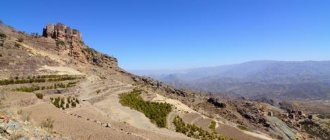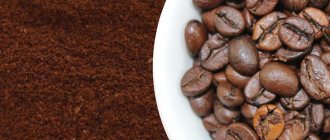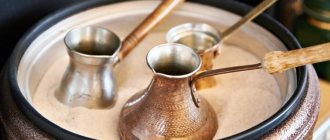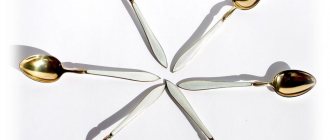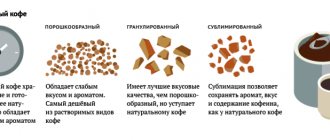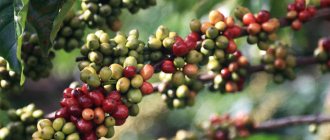Coffee is a drink that is popular all over the world. Many countries have their own traditions associated with it. The drink began to be consumed more than 700 years ago. Since that time, attitudes towards it have changed several times, as have the methods of its preparation. Interesting facts about coffee will be useful not only to fans of this drink, but will also surprise those who are neutral about it.
The birthplace of coffee is ancient Ethiopia.
Ethiopia is one of the main coffee producers in the world and on the African continent.
Coffee trees are far from uncommon in different countries, but they appeared there not so long ago. The plants that produce the bitter, aromatic Arabica beans originate in ancient Ethiopia. It was here that the trees from which all the varieties originated were first discovered.
It will come as a surprise to Robusta lovers that their favorite drink comes from Africa. The Congolese coffee tree is native to the grassy banks of the Congo River.
Interestingly, the coffee drink was first prepared not in Africa, but in ancient Arabia. Africans simply used bitter grains as a spice in cooking.
Most are grown in Brazil (about 3 million tons per year), Vietnam (about 1.8 million tons), Colombia (800 thousand tons). Where coffee beans are planted in special nurseries, providing sufficient lighting and climatic conditions. After six months, seedlings are sent to pre-fertilized fields. The first fruiting begins after two years. Coffee beans are collected by hand, with the participation of seasonal workers.
Different stories of the origin of coffee
There are several versions of the origin of coffee. The first version claims that the drink originated in Ethiopia. And the shepherd Kaldim, who was grazing goats, helped the Ethiopians learn about him. It was he who noticed how animals, after eating the leaves of a wild coffee tree, became overexcited. Kaldim told the abbot of the monastery about the amazing effect of the plant on goats. He became interested in the phenomenon and began to test the effect of the fruit on the body. Noting the invigorating effect of the coffee decoction, the abbot of the monastery began to recommend that his subordinates drink the drink in order to ward off drowsiness while standing in prayer. Local residents, having learned about the coffee tree, learned the recipe from the monks. Thanks to this, the coffee drink that originated in Ethiopia began its march throughout the world.
The second history of coffee remembers the reign of Sheikh Abd al-Qadir. Being a lover of scientific research, the sheikh paid a lot of attention to medicinal plants. Studying coffee as a remedy for headaches and poor bowel function, the sheikh in a written tradition compared it to a source of knowledge.
The next history of coffee concerns the ancestors of the Oromo tribe. It is known that African nomads, having discovered the power of the drink, constantly consumed it as food, and when they settled, they passed on their addiction to the local residents.
As you can see, the history of the discovery of coffee is ambiguous, since each legend offers its own theory of the origin of the drink. Today, only one thing can be said with confidence: the ancestor of the invigorating drink was most likely Ethiopia.
The first coffee shop in history opened in 1500
The first information about the coffee drink dates back to the 1000s AD.
The discoverers of invigorating nectar were the Arabs; it was they who brought grains from Africa and began to grow them on the Arabian Peninsula. The drink bore little resemblance to everyone’s usual coffee – cinnamon and crushed ginger coffee were added to the aromatic liquid. From the Arabian Peninsula, the coffee tree came to the Ottoman Empire. It was not until the 16th century that traders began transporting grains by sea to Europe.
It is said that the first coffee shop was opened in 1554 in the Tahtakale region by Halepli Hakem and Surieli Shems
The first coffee shop was opened in Turkey around 1500. Coffee appeared in England much later - around 1600. For a long time, only men were allowed to drink the invigorating liquid.
Bitter beans arrived in France in the 1700s; in Russia, the appearance of coffee occurred under Tsar Peter the Great. According to historians, the drink did not gain much popularity in the country. Tsar Peter had to open special coffee shops and almost force people to drink “bitter drink,” which is what his subjects called the aromatic liquid.
The history of coffee in Europe
European travelers to the Middle East returned home with stories of an unusual dark drink.
By the 17th century, coffee had spread to Europe and was becoming popular throughout the continent. Some people reacted to the new drink with suspicion or fear, calling it “Satan’s bitter invention.” The clergy condemned coffee when it arrived in Venice in 1615. The controversy was so great that Pope Clement VII was forced to intervene. He decided to try the coffee before making his decision. He liked the drink and gave his approval.
Despite heated debates, coffee houses quickly became centers of social life in Europe in the main cities of England, Austria, France, Germany and Holland. “Penny universities” appeared in England: the name came from the popularity of coffee establishments where people socialized and spent time over a cup of coffee that cost one penny.
Gradually, coffee began to replace the usual breakfast drinks of that time - beer and wine. Those who drank coffee instead of alcohol started the day feeling refreshed and energetic, and not surprisingly, their work performance improved significantly.
By the mid-17th century, there were more than 300 coffee houses in London, many of which acquired regular customers, including merchants, suppliers, brokers and artists.
Thus, travelers from Europe contributed to the history of the creation of coffee and coffee culture in the western part of the world.
The name of coffee was given by the Arabs
The origin of the ancient name “coffee” entered the English language in 1598 from the Dutch word “koffie”.
Historians do not have a single opinion on where the name coffee came from. There are several versions, the most popular and quite plausible is associated with the nomadic Arabs. “Kava” translated from Arabic means “invigorating”, “giving strength”. It was this drink that nomads used to invigorate themselves during long marches. The name was preserved, but in Western European countries the drink began to be called “cafe” or “cafe”.
Another version is associated with the province of Kafa. It was here that trees were first grown for industrial purposes and named after their country. The name has been preserved, but has been slightly transformed.
There are four main types of coffee, not two.
Arabica, Robusta, Liberica and Excelsa: four types of coffee that grow on the globe
There are four varieties of coffee trees in the world. The most common is Arabica (Arabic coffee). It occupies about 70% of the world market and is considered a leader. It has a rich coarse aroma, a pleasant strong taste with bitterness. Often used to prepare coffee blends or instant granules.
Robusta is another variety of coffee trees, significantly inferior in production to Arabica. It has a sour aroma, refined taste, and slight sweetness. Used in pure form or in mixtures with Arabica.
The most popular Arabica coffee has a rich, bright aroma and a pleasant, strong taste with a hint of bitterness.
Two more types of varieties, less known, are Excelsa and Liberica. They have much in common with Robusta, but are significantly inferior in taste. They are used to give the drink strength and lasting aroma.
Coffee growing countries
The drink got its name in the 17th century. Today, the leading country in the world in its production is Brazil. The area of coffee plantations in this country is very large, so it is compared with the area of the whole of Europe. Second and third places in the top three coffee exporters are shared by Colombia and Ecuador. It is also grown throughout Southeast Asia, Central Africa, South and Central America.
Colombian coffee is a high-grade Arabica coffee, which is especially valued in Italy, a country of coffee lovers and true connoisseurs. Coffee from Colombia is more expensive and of higher quality than from Brazil.
The main producer in Asia is Vietnam. In this country, the Robusta variety is preferred over Arabica. Coffee made from this variety of beans has a milder taste.
The first coffee was prepared at about 10 o'clock
Ancient peoples infused coffee for 5-8 hours.
In ancient times, coffee was prepared according to a simple recipe, which was used only for medicinal purposes. Whole unrefined grains, previously dried under the hot rays of the sun, were poured with water, sent to an open fire, boiled or simmered for half an hour. Be sure to insist for 5-8 hours.
Spices were added to the coffee (cardamom, ginger, cinnamon powder). The prepared infusion resembled ordinary green tea in tone and did not have much strength.
Drying and roasting of coffee beans began only in the 7th century
A few decades later, they came up with the idea of cleaning the grains, frying them over an open fire and pre-grinding them. The principle of creating the drink did not change - the coffee mass was poured with water, boiled and infused. The only difference is that the liquid was more aromatic and strong, and acquired a dark tint.
They drank coffee hot or cold and added sweet ingredients (sugar, honey). The poor segments of the population did without sweets, drinking only bitter liquid, often from poorly refined grains.
Where was coffee born as a drink?
In short, the history of coffee begins in the distant 10th century in hot Ethiopia. According to one legend, the idea of using the fruits and leaves of the coffee tree came to an ordinary shepherd, who noticed how the goats he was herding were frolicking after eating leaves and berries from a small tree in the mountains.
It was in the vicinity of a settlement called Kaffa. Soon its residents began actively preparing the drink, first from the leaves of the coffee tree, and then from fresh fruits. But the monks of the surrounding monasteries began to dry the berries and make coffee from it, and through trial and error they received the first recipe for making an invigorating drink. It was prepared not only from grains, but also from dried husks. It was the invigorating properties that prompted the monks to experiment and look for better ways to use coffee. This is a brief history of the emergence of a new product, which stretched for almost 2 centuries.
The first coffee plantations appeared in Yemen and brought prosperity to the country for several centuries to come.
Only by the 12th century did coffee culture take shape more clearly. A drink made from leaves and grains began to be prepared throughout the African continent, and it began to conquer the entire East.
Soon, coffee trees began to be grown on plantations in order to obtain greater yields and profits. This idea first occurred to one of the rulers of Yemen. For almost 200 years, this country was the main supplier of grain to the entire East, from where the expensive product began to conquer Europe.
At the beginning of the 15th century, coffee beans began to be roasted over an open fire for the first time. This merit belongs to the Turks, and they called the drink made from roasted grains Kahwa, and only after another 2 centuries it acquired its current name - coffee.
How did an unusual invigorating product penetrate into Europe? This happened only at the beginning of the 17th century. The origin of coffee and its properties were greatly exaggerated, but the taste was liked by many monarchs who gave the go-ahead to the common people to drink this drink. The triumphal march of coffee around the world begins in Italy, or more precisely, Venice, where a doctor accompanying the Venetian embassy brought several beans from Egypt. It was there that the guests were offered a hot black drink, which everyone really liked. Trade routes were quickly established between Venice and the countries of the East that grew coffee trees.
Prospero Alpini - the doctor who first described coffee as a medicinal drink and brought it to Italy
It was in Venice that the first coffee shops appeared, which became centers of social life. The first coffee to arrive in Europe was African Mocha, which gave a rich chocolate aroma and a pleasant taste. Despite the fact that Ethiopia is considered the country of origin of coffee, Yemen and Egypt began supplying the product to the world market. One of the first coffee houses, which still exists today under the name Florian, appeared in Piazza San Marco in 1720.
From Italy, grains in bags came to England, then to Holland, Austria, France, Germany and Russia. It is believed that the drink became widespread with the light hand of Peter I, but the first coffee shops were opened here after 1740. Today Russia is considered one of the most coffee-drinking countries in the world. By the way, the appearance of coffee was preceded by black tea, which was positioned as a dried invigorating herb.
The structure of the coffee berry includes four layers
Usually there are two grains in a coffee berry, but sometimes during pollination only one develops.
A coffee berry, regardless of the type of tree, consists of four layers in structure. The upper part is a silvery thin skin covering the grain. During frying, the film turns into a fragile husk, which easily lags behind the walls of the main part.
The parchment shell is the next layer of the berry, quite hard and dense. The purpose of the patch is to protect the interior from damage and temperature changes. Peeling of the parchment shell is usually carried out before transporting the grains to protect the goods from loss or damage.
Another layer of the berry is gluten, which has a high percentage of sugar content. The adhesive shell is often confused with the core. Gluten is not removed when grains are cleaned - the sweetness or bitterness of the drink depends on the quantity. The core of the berry is the pulp. It is this part that is used in making traditional coffee.
Coffee is a real cornucopia of nutrients. The berries contain:
- vitamins (B1, B6, PP);
- caffeine;
- tannins;
- carbohydrates;
- minerals (potassium, iron, zinc, calcium);
- proteins.
It is believed that the higher the coffee tree grows, the more aromatic the drink is obtained from its beans. The
beans also contain a high percentage of acids, which, when heat treated, provide the drink with a persistent strong aroma.
7. The traditional method of cooking was invented by the Arabs
First, high-quality green grains were fried until brown.
Many recipes for preparing an aromatic drink have been preserved by the Arabs. The process of brewing coffee turned into a real action, which is why it took at least an hour. Only high-quality grains were used, always green.
Clay cups were filled one third with green grains and covered with hot coal from fruit trees. The next step is frying until brown. Each grain was taken out and carefully examined - if burnt or undercooked areas were found, the raw material was thrown away.
After brewing in a Turk, the coffee was poured into small cups and immediately served to the table.
The roasted grains were ground using wooden mortars into a fine powder resembling dust. The required amount of coffee was poured into the Turk with cold water and placed on low heat - the drink should not boil, but simmer slightly. The prepared aromatic liquid was poured into a large clay container, infused a little, poured into small cups, and immediately served to the table.
The first interesting legend associated with coffee
The properties of coffee were first discovered by the Ethiopian shepherd Kaldi, who noticed that his goats became energetic after eating berries from an unfamiliar tree.
There are many legends associated with the coffee drink. One of the most interesting is related to the discovery of coffee. According to legend, we have goats to thank for the invigorating drink; it was they who helped discover the properties of berries from coffee trees. One day, a shepherd grazing animals in a coffee grove noticed that the goats were happily chewing the leaves and red fruits of the tree.
At night, the shepherd was in for a surprise - the goats didn’t even think about going to bed, they moved briskly and showed no signs of fatigue. The frightened man shared his observations with the abbot of the monastery, located not far from the pasture.
The monastery decided to take advantage of the discovered qualities of coffee - an infusion prepared from the berries was given to the monks, who had to stand nights in prayer. Only many years later did the clergy learn to roast the grains, grind them and prepare invigorating nectar.
Where did coffee originate?
Almost immediately after the discovery of the coffee tree, people began to soak its fruits and make decoctions from the leaves and peel.
The grains, found by an Ethiopian shepherd, were brought to the Arab Peninsula. The sale of coffee came from there. The drink began to spread in Yemen in the 15th century, and another century later - in Persia, Syria, Egypt and Turkey. By that time, people had learned to roast grains.
The first coffee houses appeared in the Middle East. Since then, people began to drink coffee not only at home: they preferred to spend time drinking an invigorating drink rather than engaging in active activities. In coffee shops you could listen to music or play chess; they quickly turned into meeting places and exchange of news.
In the mid-17th century, coffee was brought to New Amsterdam, which the British later called New York.
On the plantations, each worker collects up to 700 kg of grains per day
Coffee beans are collected only by hand.
It is often mistakenly believed that coffee berries grow on bushes. Valuable plant materials used to prepare an invigorating liquid are collected from trees. Plants can grow up to ten meters and develop a gorgeous, huge crown. It is difficult to collect berries from large trees; special equipment is required, so already 3-4 years after planting the seedlings, pruning begins. The optimal plant height is 3-4 meters.
Collection is carried out only by hand. The beans are sent into large wicker baskets that can hold about 100 kg of raw materials. One worker can collect up to 7 such baskets per day. The payment for the work is quite high - 8-10 dollars for one braid.
You can harvest up to 1.5 thousand berries per year from one mature coffee tree.
The age of coffee trees is up to 70 years. The largest number of fruits are harvested in the first ten years after the start of fruiting. Every year the plants produce fewer and fewer grains, so it is not advisable to keep the trees for a long time - 20-25 years after planting they are uprooted, the soil is fertilized and young seedlings are planted.
Bach and Voltaire were coffee lovers
Voltaire lived to the age of 84, despite the fact that the doctor promised the philosopher an early death due to his passion for coffee.
History says that many famous personalities preferred coffee to other drinks. One of them is the French philosopher Voltaire, who believed that it was to aromatic nectar that he owed outstanding achievements. Voltaire drank up to 50 cups of the drink per day; most of the money he earned was spent on such a hobby, so the heirs were left with only minor savings.
Johann Sebastian Bach was also considered a real coffee gourmet, fond of drinking the invigorating liquid. The composer was slightly inferior in the amount of coffee consumed to the philosopher Voltaire - 15-20 cups of strong drink were enough for the great musician per day. In the 1700s, Bach created the famous Coffee Cantata, dedicated to bitter nectar. The work has humorous notes - it glorifies the necessity for the human body and some dependence on coffee.
Report No. 2
Coffee is one of the indispensable and most popular drinks in modern society, which is considered the most aromatic in the world. Origin.
Initially, as legends say, coffee originated more than 1,500 thousand years ago in the 3rd century AD in Ethiopia. It is in this state that coffee still grows like a wild plant. However, it was brought into the public domain from Yemen, where it was supplied as contraband by the Arabs, from whom specific documented information was later discovered in the 10th century.
In the 17th century, there was a great demand for coffee, which is why many Europeans began to look for tropical places suitable for growing these plants. The Dutch were the first. They were able to steal some grains from the Arabs, after which they planted them in Amsterdam. A few years later, thanks to this, the famous biologist Carl Leaneus created an entire plantation that he called: “Arabica Coffee.”
And although its history is so rich, coffee began to be studied in depth relatively recently: about a couple of decades ago.
Growing.
Coffee beans are very finicky when cultivated, especially the above-mentioned Arabica variety, therefore when growing, the first thing to take into account is the temperature, which should not exceed 20-25°C and becomes below 8°C.
Soil is also an important component. Most people use loose soil with an average moisture and nutrient content.
Varieties.
The coffee tree belongs to the Madder family, which includes 60-80 varieties; only 3 are cultivated in all 80 countries: Arabica, Robusta and Liberica. There are several types of coffee on the market:
- Grain
- Ground
- Soluble
- A recently introduced milicano that combines the properties of the previous two.
Numerous drinks made from these grains are common in industry, in addition to the main one:
- Espresso
- Cappuccino
- Glasse
- Latte
- Mocha
- Mocaccino
- Americano
- Ristretto
- Romano
- Turkish coffee, which is regular strong brewed black coffee.
Effect on the human body.
Coffee has both negative and positive effects on the human body. In first place is caffeine, which dilates blood vessels, accelerating blood circulation, which is why people subsequently feel alert. However, in recent years it has been discovered that it also lowers the concentration of proteins in the brain, which helps relieve dementia. When drinking a drink, a person feels euphoria - joy, but if you drink too much, its advantages will turn into disadvantages, therefore the recommended amount is 3-4 cups per day.
Interesting Facts.
Many people who believe in paranormal events claim that the number 8, denoting infinity, is closely associated with coffee, which is why new legends are born that it is marked by higher powers.
5th grade
Coffee has its own holidays
In Costa Rica, a coffee festival is held annually on September 12, with bright, masquerade, theatrical performances.
Many countries in which coffee is a traditional drink celebrate the holiday of this invigorating aromatic nectar. In Costa Rica, the celebration occurs in September. On the 12th, colorful festivals and fairs take place; cafes and restaurants offer all kinds of drinks with the main ingredient – coffee beans. At night, a fantastic action begins - fireworks, theatrical performances, masquerades.
Ireland is another country where coffee is revered so much that they decided to make it a holiday. September 19 is the day when most of the country's residents go to the streets to enjoy a cup of aromatic nectar with friends, acquaintances, and just passers-by. Many families have a tradition of gathering around the festive table; every home has a traditional recipe for making coffee, passed down from generation to generation.
Popular message topics
- Animals of Antarctica
Antarctica is a territory with harsh climatic conditions. The temperature of the mainland is very low, and the entire territory is covered with thick ice. Despite such conditions, there is a variety of flora and fauna here, which surprises us with its - Mechanical engineering in Russia
Mechanical engineering is one of the leading areas of industry in our state. The branches of mechanical engineering in Russia are numerous and diverse, their specialization accounts for the production of a huge number of products, - Ballet
Ballet is a very subtle, beautiful and aesthetic theatrical art. Ballet originated in Italy in the mid-sixteenth century. The name ballet comes from the Italian word “ballo”, which means dance. At first the ladies danced on stage in long dresses,
The drink is not recommended for athletes
It is better for professional athletes to stop drinking coffee so as not to harm their career.
Coffee is a drink that is not welcome in sports. Doctors warn that abuse leads to health problems. Even a small amount of caffeine is undesirable if a person is involved in intense sports - the International Olympic Committee has put the substance on a par with cocaine and steroids.
Drinking about five cups of hard liquor by an Olympic athlete will result in disqualification. This amount of coffee increases the level of caffeine in the body, which is considered an attempt to increase energy and endurance, reduce sensitivity to injury, and gain an advantage in a fight or singles performance.
Harmful properties of coffee
Despite all its benefits, coffee is not the healthiest drink in the world. It increases blood pressure, is harmful to pregnant women and is addictive. In addition, scientists have discovered 18 more harmful properties of coffee.
Caffeine, a key component of coffee, is the most abused drug in the world.
Coffee can lead to insomnia
Coffee energizes us, but this property is harmful when we try to sleep. The energizing effect of caffeine begins to be felt 15 minutes after consumption, but it lasts much longer. It takes about six hours for the stimulating effect to wear off by half.
If you want to get enough sleep, try not to drink coffee in the afternoon. Or at least 2-3 hours before bedtime.
Coffee affects the effect of medications
If you are taking any medications, be sure to ask your doctor if you can take them with coffee. This drink may enhance, weaken, or even change the effect of the pills.
For example, researchers studied the behavior of alendronic acid (an osteoporosis drug) when taken with water and other beverages. Studies of the oral bioavailability of alendronate. . It turned out that black coffee and orange juice reduce the absorption of the drug by 60%. And the effect of thyroid drugs is reduced by 55% if you take them with coffee. Altered intestinal absorption of L-thyroxine caused by coffee. .
In addition, the situation may be the opposite. Medicines can enhance the effects of coffee, causing you to feel the caffeine euphoria for longer. So be sure to consult your doctor.
Coffee may worsen acid reflux
One of the symptoms of acid reflux is heartburn. This unpleasant sensation occurs when the lower esophageal sphincter (which separates the esophagus and stomach) does not close in time. Then the gastric juice enters the esophagus.
Coffee has extremely high acidity. Once in an acidic environment (stomach juice), it will cause the esophageal sphincter muscles to relax. And this can cause or worsen heartburn. Decaf coffee also poses a threat. According to some studies, such coffee increases the level of acidity in the stomach, stimulating the production of the gastric hormone gastrinEffect of Decaffeinated Coffee on Health. . And this causes the release of gastric juice.
If heartburn bothers you twice a week or more, you should give up coffee. If you have heartburn, you should also drink tea, citrus juices, milkshakes and alcohol with caution.
Coffee can cause indigestion
Drinking a cup of coffee on an empty stomach stimulates the production of hydrochloric acid, which can lead to serious digestive problems. Hydrochloric acid is usually produced in the stomach when food enters it and is used to digest proteins and fats.
If too much of it is produced at one meal (when you ate a lot of fatty foods or drank a lot of coffee on an empty stomach), the next time it is not enough, then the food will not be completely digested. This can lead to bloating and stomach discomfort, and in severe cases, irritable bowel syndrome and even colon cancer. So try not to drink coffee on an empty stomach.
Coffee may work as a laxative
Coffee stimulates contraction of the intestinal muscles. This would seem to be a good thing because coffee can help with constipation. But this property of coffee can also cause a number of problems, such as gastric emptying. The effect of coffee on gastric emptying. . Then all the contents of the stomach enter the small intestine before the food is completely broken down and digested. The nutrients from such food simply do not have time to be absorbed, and this can lead to intestinal inflammation.
Coffee contains carcinogens
When coffee beans are roasted at high temperatures, they can form acrylamides. These substances are considered carcinogenic and genotoxic by EFSA publications report on monitoring and exposure assessment of acrylamide.
Although dangerous levels of acrylamides are found in a variety of foods, coffee is a major source of these substances. The darker the roasted coffee beans, the more acrylamides they contain.
Coffee makes it difficult for platelets to work
Platelets are blood cells produced in the bone marrow. They help stop bleeding by clogging the damaged vessel.
In 2008, researchers studied the effects of coffee and caffeine on platelets. Study participants drank coffee or caffeine capsules and water. Effect of coffee drinking on platelets: inhibition of aggregation and phenols incorporation. . And in those who received only caffeine, the properties of platelets did not change.
It turns out that decaffeinated coffee will not solve this problem. And it can lead to serious consequences for those who suffer from anemia or other diseases associated with blood clotting.
Coffee may reduce the chance of pregnancy
According to researchers from the University of Nevada at Reno, fallopian tube activity is reduced in those who regularly consume caffeine. The inhibitory effect of caffeine on pacemaker activity in the oviduct is mediated by cAMP-regulated conductances. . These tubes transport eggs from the ovaries to the uterus. A study conducted on mice found similar problems in rodents that were given caffeine.
Coffee increases cholesterol levels
Cholesterol is a fatty substance necessary for the production of hormones and other substances important for the body. But if too much of it is released, it gets deposited in the arteries. And this leads to various problems with the heart and blood pressure.
Coffee contains a cholesterol-raising substance called cafestol. One study found that five cups of French press coffee contained 30 mg of cafestol. Effects of cafestol and kahweol from coffee grounds on serum lipids and serum liver enzymes in humans. . If you drink five cups of coffee a day for four weeks, your blood cholesterol levels will rise by 6-8%.
Paper filters used in the coffee brewing process will help protect yourself from cafestol. They will hold up most of the cafestol.
Coffee may cause osteoporosis
Osteoporosis is a bone disease in which bones lose their density and become honeycomb-like. It is especially dangerous for older people.
Calcium is essential for bone health, and caffeine reduces calcium absorption. With every cup we drink, we lose about 4-6 mg of calcium. Caffeine and the calcium economy revisited. . According to scientists, caffeine intake increases the rate of bone loss in elderly women and interacts with vitamin D receptor genotypes. .
Coffee makes us crave sweets
Caffeine increases cravings for fruit juices, sodas, and other sugary drinks (which are addictive in their own right). This was confirmed by a randomized controlled trial conducted by Australian scientists. Caffeine increases sugar-sweetened beverage consumption in a free-living population. .
Study participants were divided into two groups: some drank caffeinated drinks for several days, and others did not. The researchers then analyzed the participants' diets. It turned out that participants in the first group drank 419 ml of sweet drinks per day, while participants in the second drank only 273 ml.
Coffee reduces iron absorption
Iron is necessary for the production of hemoglobin. This protein, which is part of blood cells, carries oxygen from the lungs to other parts of the body. Even if your diet is rich in iron or you take a supplement, your body will be less able to absorb iron if you drink coffee. Just 150–250 ml of coffee will reduce iron absorption by 35%Effect of different drinks on the absorption of non-heme iron from composite meals. .
Coffee can cause mastopathy
With this disease, lumps form in the mammary glands, which increase in size and hurt during menstruation. The exact cause of the disease has not yet been established; scientists suggest that it is related to hormones. According to one clinical study, in women who consume 30 to 250 mg of caffeine per day, the risk of mastopathy increases by 1.5 times. Caffeine Consumption and Fibrocystic Breast Disease. .
Coffee irritates the gastrointestinal tract
For those who suffer from gastritis, ulcers or intestinal problems, doctors advise giving up coffee altogether. It is quite possible that he led to the occurrence of these diseases.
One of the causes of ulcers is the bacterium Helicobacter pylori. Coffee, due to its acidity, corrodes the mucous membrane of the stomach, and this creates a favorable environment for bacteria. Of course, a strong immune system can protect against this, but not always.
Coffee can also cause serious harm to the lining of the small intestine. You may get cramps, colic, constipation or diarrhea.
Coffee increases anxiety and stress
Coffee stimulates the production of adrenaline, norepinephrine and cortisol. These hormones trigger the body's fight-or-flight response. This seems like a good thing because we will feel alert and full of energy. Only too much of this energy is produced, so we begin to twitch and get nervous.
This happens because caffeine blocks the production of gamma-aminobutyric acid (GABA). This neurotransmitter is involved in inhibition processes in the central nervous system. It relieves us of anxious thoughts. When GABA is not released, we experience stress.
Coffee may increase the risk of miscarriage
Researchers from the National Institutes of Health and Ohio State University analyzed observational data from 500 couples. Scientists have looked at the relationship between the presence of chemicals in the environment, the lifestyle of parents and their fertility.
It turned out that the risk of miscarriage was higher if both partners drank more than two cups of any caffeine drink per day in the weeks before conception. Couples' pre-pregnancy caffeine consumption linked to miscarriage risk. . The risk of miscarriage also increased if women drank coffee in the first seven weeks of pregnancy.
Coffee increases blood pressure
You may have high blood pressure for years, but you may not know it. But even if symptoms are not noticeable, the blood vessels and heart are still damaged, and this can lead to serious consequences (stroke or heart attack).
Italian researchers analyzed data from more than 1,200 patients aged 18 to 45 years with first-degree hypertension. Those who drink a lot of coffee are at risk of developing high blood pressure (the risk increases fourfold) Coffee consumption and risk of cardiovascular events in hypertensive patients. . For those who drink moderate amounts of coffee, the risk increases threefold.
Coffee can cause incontinence
Researchers from the University of Alabama found that coffee has a relaxing effect on the bladder. Caffeine and urinary inconsistency in US women. . Consuming more than 200 mg of caffeine per day leads to urinary incontinence.
Desserts are made from coffee berries
Coffee beans are widely used in preparing and decorating desserts.
Despite the fact that coffee is considered a drink, many people prefer to consume dry roasted beans. Some companies have turned this taste craze to their own benefit - flour is prepared from coffee residues, used for making sweets, desserts, and baking bread.
Flavorings are often added to such baked goods. Sweets with the aroma of fruits, berries and the taste of coffee are a gourmet dish, especially if served with a cup of an invigorating drink with milk or cream.
Coffee: history, types, production features
Good day, my dear readers. In one of the Friday selections of cocktails with coffee, I promised to tell you, in fact, about coffee. Then it somehow didn’t work out, and I was carried away into a slightly different topic. Actually, I must approach this drink with all responsibility, because coffee is a mystery of taste that deserves special respect. For those who have been drinking creepy black liquid from a can with “Nescafe” scratched all their life, the articles in the section on coffee that I just opened are a must read.
So, what does the almighty Wikipedia tell us about coffee? And she says that coffee is a drink that is prepared from roasted coffee beans , more precisely, from the beans of the coffee tree. Perhaps we can agree with her


